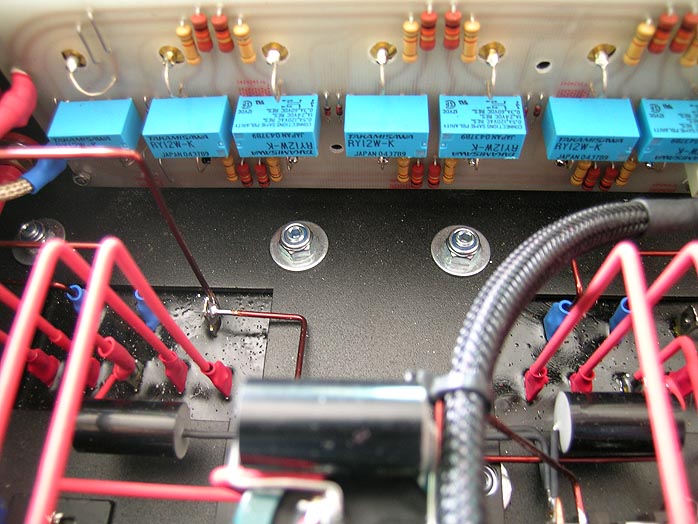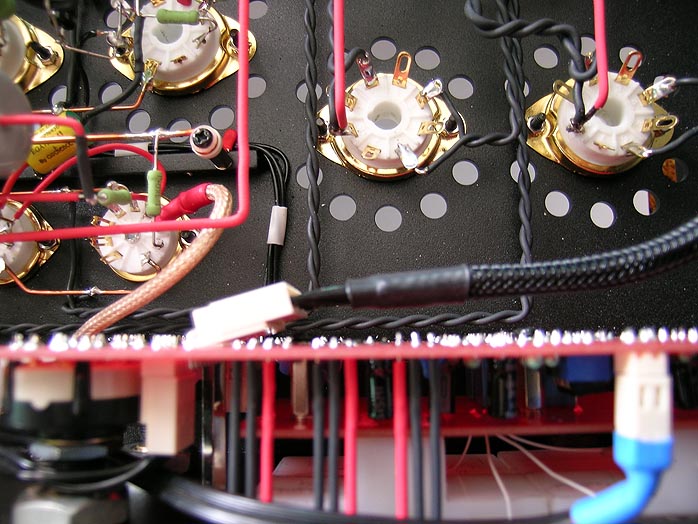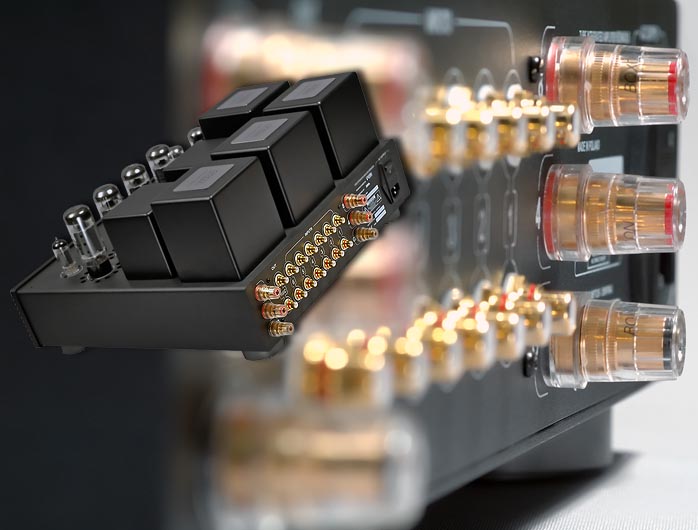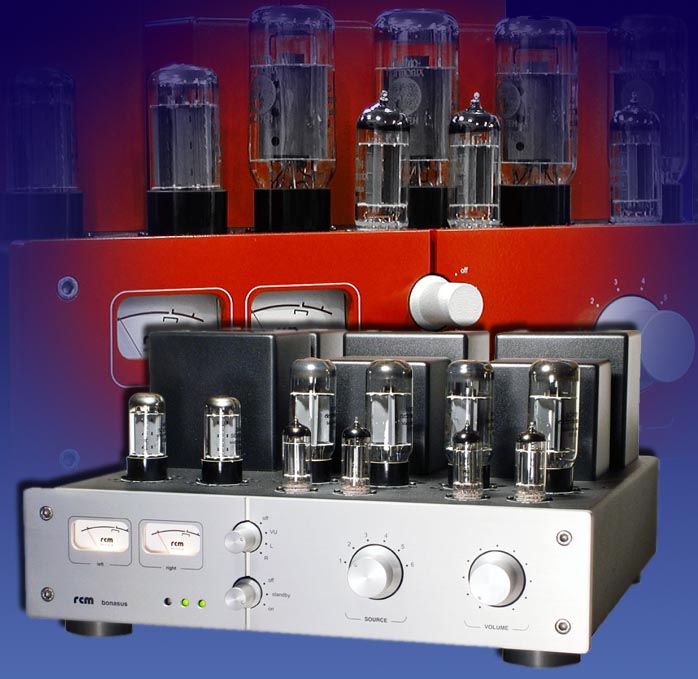|
This review page is supported in part by the sponsor whose ad is displayed above
|
|||||||||
 |
|||||||||
| Madness alert. To test the Bonasus with my customary Zu Definition Pros, I hoped to generate a dedicated variable feed for their bass arrays. I normally use the Music First Audio Passive Magnetic upfront for that purpose and with integrateds that lack a variable pre-out. However, I netted a serious ground loop as a result, a first for me I didn't manage to beat. On a lark, I decided to leash the Bonasus to my 82.5dB Mark & Daniel Ruby monitors to hear the amp full-range while I was planning my next obvious strategy, the fixed outputs. Hey, I did say madness. To level the playing field just a tad, I opted for the Raysonic CD128's standard output voltage rather than the half-dose 1V feed from my Zanden DAC. I'd need all the signal strength from the source I could pass to the pugilist to do his thing into these power-hungry minis. |
|||||||||
 |
|||||||||
| When it comes to amplifier drive, power supply is everything. Should I have been surprised to discover that the pound-foolish Polish heavyweight acquitted itself with top honors in this shouldn't-work scenario? Granted, its attenuator sat at nearly 4:00 for customary levels. The VU meter hit 75% to 90% on peaks, monitored carefully to see how close I'd get to clipping. I didn't run symphonic mayhem. I didn't have a whole lotta headroom to go daft and deaf. But Святейшая гречиха if it didn't sound splendid. More impressive yet, this insanity didn't betray any audible limitations in bass or overall control, a test the 18wpc Raysonic tube integrated flunked into the far more efficient 88dB Gallo Ref 3.1s. Needless to say, this setup wouldn't do for serious review purposes. It was far too unrealistic and ultimately limited. But, I did leave it in place for a full day as though to assure myself that I hadn't eaten hallucinatory mushrooms. And while Babelfish doesn't offer a Polish translation for "Holy crap!", the above Russian rendition should suffice. Just to be sure that the relevant translation -- on what this silly test proved -- comes across, let me stress that it worked without apologies. I got exactly the SPLs I need and always use to listen and review. The performance wasn't just credible, it was top notch. Should there have been any doubts, they'd been put to rest. The Bonasus is one serious amplifier. Its 16wpc rating not only sounds far bigger than it reads, it's got the power supply backup muscle to behave far bigger even into sub 4-ohm loads. One cover-to-cover reading of Mercan Dede's synth-ridden drum-heavy Nefes [DoubleMoon 033] proved this conclusively. (RCM reportedly drives big Isophons in a large room with no problems, a load that hits 2 ohms in its band.) |
|||||||||
 |
|||||||||
Color me impressed by this show of muscle. To get my Definition Pro setup to work, I simply leashed their bass arrays to the fixed output. Sure, I had to manually adjust the input level slider on the Rane each time I altered the main volume but it was sonically uncompromised. Seeing that the Bonasus nearly suffers redundancy with its 6 inputs, perhaps one of those could be hijacked for bi-amp scenarios (including active subwoofin') and get transformed into a variable output? RCM has looked into this but concluded that the maximally tweaked circuit at present would take a hit in dynamics and noise performance if a variable output were added. Too bad. That would be a valuable feature for some of us. |
|||||||||
 |
|||||||||
With the low-output Zanden back in the loop, imagine my surprise when the Bonasus attenuator still sat at 2:00 or even 3:00, now into 101dB speakers. Either the amp's input sensitivity was uncommonly low or the Bourns attenuator deliberately used a very shallow taper to broaden useful volume values in the most critical range where many pots go from quiet to loud too quickly. This could confuse certain shoppers. They might think the amp had broken in transit. Not. With my 1-volt source, I simply listened higher on the dial and thought no more of it. The VU needles barely moved past 25%. On my Raysonic CD128, this listening window moved west by about 3 hours and sat between 11:00 and high noon. RCM's man in Oz Warwick Freemantle confirmed that on his 2-volt source and in a listening room of 5.1m x 12m -- roughly 15' x 36' -- he too runs his Bonasus at 2:00 into his standard Definitions. Over mine, there was a faint bit of self noise with the Zanden fronting it, albeit completely inaudible in the seat and detectable only with the ear on the driver. The Raysonic was even quieter and essentially undetectable even with meanness in mind. Checking with RCM, the Bonasus indeed does run an uncommonly low 2V input sensitivity. What's more, the logarithmic Bourns pot comes on deliberately late for the reason already suspected. The carbon-film resistors controlling gain were specifically chosen for superior performance at very small signal voltages. |
|||||||||
 |
|||||||||
Sonically, 'twas an impressive Ruby rerun. The Bonasus is a very smooth, slightly round-around-the edges, laid-back operator with enormous stage depth and great solidity, especially in the 40-120Hz power band which my Zus handle with their passive frontal arrays. The Bonasus wall of sound is a bit less concerned over shining the light into the smallest of crevices and more with illuminating the entire stage front to back. It doesn't have quite the apparent speed, bite or last bit of articulation my 45s evince. There's more transient incisiveness with the triodes, more holographic dimensionality right around the individual performer and how he or she is sculpted against the surrounding space as lit up by the higher harmonics. The Bonasus sound is a bit more comfort - more mass, less jump. That's relatively speaking of course, vis-à-vis my Yamamoto which is completely and utterly useless to most punters due to its lack of real power. Still, it's a compelling argument to throttle back your power needs as far as possible. Get truly sensible - er, sensitive speakers and grab a hold of one of them direct-heated triode amplifiers. Once you've fallen for their charms, most anything else will sound just a bit packed in cotton, its blood flowing just a bit slower through the veins, the sense of one-on-one intimacy just a bit more distanced. Naturally, OTL fanciers say the same about their objects of desire (although I've found the ones I've heard too lean and harmonically bare-boned). I shall not harp on this topic, however. Experience suggests that you simply cannot get that particular micro-power DHT flavor from push/pull amps and EL34s. It's a white men can't jump thing. |
|||||||||
 |
|||||||||
What you get instead is faze coherence. That's not a new crossover circuit. Its a humorous yet serious bow at the fact that superior power supplies remain unfazed when you start pulling out the challenging software. That quality of imperturbability is audible during a long Bruckner crescendo, a sudden all-orchestral tutti outburst that redlines instantaneously, a violent rim shot that's been miked up close, big drum whacks, the overall density of gestalt. Nothing compresses or moves inwards. Everything stays put and swells outwards and upward. Images don't blur, waver or clump - all the good stuff monster amp makers tout to get you into buying their 2000-watt into 1-ohm arc welders. Within its far more realistic power range, the Bonasus is just such an amp. Accordingly, it won't dictate what music to feed it and what to stow away for sunnier days and bigger amps. The easeful nonchalance of standard SPLs simply scales while its innate character of unfazedness remains stolid. You've thus got sonic and psychological relaxation. Nothing in you clenches even subliminally when the next big impact comes along and you're loud already well before the climax. Again, this amplifier circuit is readily capable of producing more than double its specified output power. There's real headroom. Though listening at 2:00 might suggest otherwise, things go up steeply from there. The very lazy taper kicks up and SPLs increase more rapidly. Things are just as they should be. Think slow burner, then no more of it. In keeping with its no-nonsense first impressions, the Bonasus is a muscle amp that sounds terrific. Those twain -- brawn and finesse -- do not always go hand in hand. Here they do. Bass bombs drop with full impact and spread out in pressure waves through the room. They propagate and ripple rather than seem lazy and stagnant. Vocals are enfolded by their surroundings rather than separated out, different in perspective from my triodes. Ditto for details like dripping water or whispered talk. There are less splashes, literal and figurative, on the plosives. Violin spiccato has less rasp on it. In the elemental simile where metal, wood and air stand for transient, bloom and decay, the Bonasus is more wood than the triodes and less metal and air. The sound is weightier, heavier indeed -- neither dark nor warm per se as I don't detect deliberate voicing by way of tonal balance shifts -- but definitely very substantial. |
|||||||||
 |
|||||||||
Decays aren't as obvious as I'm used to though they're fully present when you concentrate. It sounds as though they pass through greater density. They're less overtly floating and sparkling on top like fizz on a drink but seem somewhat submerged in the sonic liquid. Guitar arpeggios with their sharp attacks both on Flamenco and Manouche Jazz again express less metal on the transient, as though a steel string was wrapped in a bit of very fine silk. I come back at the prior statement of being concerned with the bigger picture. That's the Bonasus. It's a far-view amp rather than one that inspects thing from really close up. It's coffee with milk, not the pungent, slightly acidic black straight. If you're into bite, the Bonasus won't fully oblige. That seems neither the nature of its chosen output tubes nor why folks flock to them. No, the reason to circle around the camp fire stoked by EL34s is tone. Throw in image density too. That nearly always accompanies systems with good tone. And wouldn't you know it, the Bonasus aces that combo. It's tonally fat. Add the fact that I was listening to paper drivers -- forget ceramics, they simply don't do tone -- and you can imagine how I was wading in tone. Lest that conjure up congestion, it wasn't. It was simply luxuriously toneful like a Bösendorfer played in a room with heavy tapestries. Even potentially nasty music benefitted. It got less edgy and annoying, gaining a few pounds in trade. As RCM's Roger would tell you, if listening to music isn't pleasant to make you want to stick around and hunker down, he couldn't be bothered. The Bonasus is his baby and it shows. Now add very expansive lateral staging whereby the width of your room becomes the scenery. No wonder this amp sounds big, juicy, friendly, comforting, weighty and strong. It's got that gentle giant persona going. Listener fatigue isn't part of its vocabulary. Nor is etching or highlighting. On the flip side, this also excludes extreme vocal lock or the sheer fiery brilliance of a vigorously bowed Russian fiddle scaling flageolet toward the bridge. Of course my comments deal with the stock tubes. It's a subject RCM feels strongly about as opposed to promoting excessive rolling. Compared with the Eastern Electric M520, the Bonasus clearly belongs to the same sonic family tree but is a more advanced, grippier version with a completely different set of balls and quieter operation. That's not dissing the M520. It's $1,800, comes with a full-function remote, is built beautifully and a super value. But there's life beyond it if your wallet can expand. The Bonasus demonstrates what it is - more articulation, welly and scale. In short, more muscle and control. |
|||||||||
 |
|||||||||
Personally and for my primary big rig, I'm a 45 man. I need more caffeine, spunk, air and jump. I'll trade that against a reduction in mass, displacement, density and warmth. I'm big on microdynamics and seeing transients cut through the surrounding thicket. The Bonasus restacks the deck in favor of the aforementioned qualities. I will also say that to tweak a system around my personal values makes it far more likely to err and end up with too much metal and not enough wood. That's fatiguing and unpleasant. Getting it just right can be a long road. The Bonasus is a short cut to avoid any of that business. It'll take far more abuse with nastier music and lesser CDs without rendering them painful. It's what our Jeff Day would call a bona fide music lover's amp. Our Chip Stern calls it comfort food - potatoes and beef dripping with sauce in a heapin' helping. Of course you understand that any such characterizations are like caricature sketches always. They hone in on a few salient key features and overdo them for emphasis and to make the subject stand out from the crowd. In the end, it's about degrees and how partnering gear -- in this case, speakers primarily -- will either compliment or exaggerate certain aspects. On my Mark & Daniel Ruby with Omni Harmonizer, the Bonasus would be the ideal amp if it had a bit more gain to compensate for their low efficiency. Into the slightly electrostatic Gallo Reference 3.1s, the Bonasus is perfectly suited and more than amply endowed on the power meter. Into my Zus and off the Raysonic CD 128, the tone/density thing took undue precedence. It unseated the overall balance a bit farther than ideal, especially at lower to mid volumes where I found it to get a bit opaque. When it came time for crank city however, those very qualities were more and more welcome and changed in prominence. |
|||||||||
 |
|||||||||
For a reality check, I finally preceded the Bonasus with my Supratek Cabernet Dual preamp set to medium gain, Zanden digital upfront. Knowing that the Zanden DAC couldn't drive the RCM integrated to full output, I used the tube preamp to pad the digital output, mindful to back off the max 27dB of preamp gain (the dream machine from Oz offers four different levels of transformer-coupled gain settings independent of the master volume control). Now I was hearing the Bonasus in its very best light. The Zanden's increased ambience retrieval became the necessary counterpoint to avoid the minor clouding at lower volumes noted earlier while the infusion of drive and current in the Supratek enhanced microdyamic charge over the affordable Raysonic which is no slouch in that department. |
|||||||||
 |
|||||||||
Ideally, I would have used an Esoteric X-03SE or equivalent source of premium resolving power, neutral tonal balance and a minimum 2V output. However, my mocked-up scenario above made the point sufficiently. The Bonasus -- which amp doesn't -- deserves the very highest quality input signal you can generate. This will downplay its EL34-ish push/pull signature, especially if you come from the faster, more lit up and energetic shore of the thermionic river. Wrap-up time now. The mechanical design and construction of the Bonasus is A+. Raw drive is top class and far beyond what the power rating could possibly suggest. On the feature front, a variable output and remote would be nice additions but RCM is one of those companies. They won't add features if they constitute even the smallest performance infraction. Why these two features should be an infraction isn't for me to question. I take it at face value being told. I would think however that the option to turn off the VU meter backlighting without sullying sonics should be doable without compromising the piece. Some listeners like myself may wish to do without those light sources during late-night sessions. There are no operational quirks other than -- on hi-eff designs -- a minor speaker pop on power down (not up). The amplifier never exceeds warm in operation even after playing 12 hours straight. Forget hot, it never gets it. It is exceptionally heavy and will require planning to hoist onto a high petard which'll need to be appropriately sturdy especially in the back where the weight is concentrated. Because of its very low input sensitivity, the Bonasus wants to see a 2V standard source to be driven to full output. That's the industry standard anyway. 1-volt digital players like my Zanden are the very rare exception which would not get the full power from this amp if your speaker needed it. |
|||||||||
 |
|||||||||
I can only speculate based on appearance and obvious fanatical construction that reliability of this amp will be top notch and tube life long since a deliberate choice has been made to forsake ultimate output power. The valves aren't being stressed to sound good. Sonically, I can detect no liabilities, imbalances or areas of concern that would be noteworthy to anyone considering an EL34-based push/pull integrated. In fact, the Bonasus -- minus the inevitable glitz of Rodeo Drive brands -- is probably as good as it gets on this exact street corner of the audiophile 'hood. Unless you like to spend extra money on gold-plated face plates and consider that mo betta still. This truly is a no-nonsense, very high performance amplifier. It's also an industrial-strength machine for heavy duty work and tougher loads. Think Chevy ad. Additionally, it's a musical pleasure device, a bonanza of tone. Bonasus and bonanza - I just had to tie that knot. The Bonasus is quite the combo. Its only liability is a possible perception hurdle. 16 watts on paper for an EL34 push/pull amp don't seem terribly impressive. That's only perception. Think 50 watts to properly assess how this machine behaves in actuality. And it's from Poland no less. Audiophile obsession knows no borders or bounds. Καλοψημένος, φίλοι. According to Babelfish, that's Greek for "well done, friends". Polish wasn't on their translation menu. Thankfully, audiophiles are far more globally adventurous to cherry pick their choices wisely. Wherever they may be from ... |
|||||||||
 |
|||||||||
 |
|||||||||
|
Manufacturer's website
|
|||||||||
 |
|||||||||